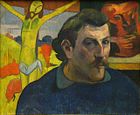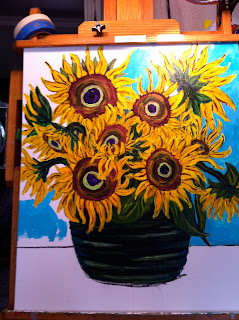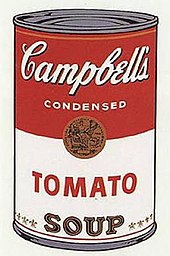But did you know that Vincent painted these famous flowers many, many times?
All together, Vincent painted a dozen or so versions of his famous Sunflowers during two significant periods of his life.
The first (of at least four) paintings were done in Paris, when he lived there with his brother, Theo.
The Parisian Sunflowers (below) are less iconic than the Arles (shown in the book, left) versions, depicting a series of just a few flower heads lying on the ground. The version you see below is his final one in this series; it is a compilation of several earlier oil "sketches" that Vincent had started with.

These sunflowers, however, were only a prelude to the masterpieces Vincent made in Arles.
As I mentioned, the Paris sunflowers were made during the time that Vincent lived there with his brother.
| Theo |
In the Art World, Theo Van Gogh was a very important man in Paris in the late 1880's. Theo was smooth, poised, and polished. As the company had evolved, Theo had been put in charge of a Groupil Gallery (the entresol) which bought and sold the works by the (increasingly popular, and newly establishment) impressionists, and, then later, by new and rising modernists. Anyone who harbored any ambition as an artist knew of Theo, and many actively courted his midas touch of favor. Theo had a keen eye, and his expertise helped to further or make the careers of artists like Monet, Degas, Lautrec, and Pissarro.
In orbit around this golden boy circled every up and comer in Paris. Being noticed by Theo Van Gogh meant the opportunity to get your work shown to and seen by the right people: critics, the art establishment, and those with large bank accounts, modern taste, and empty walls. But to get to Theo, first you had to get past Vincent.
Theo and Vincent lived together at this time in an apartment on the rue Lepic. Theo had paid for studio space there for Vincent to work, and was providing for all of his needs. Theo had positioned himself with the right job, the right connections, and the talent to be a major player as the head of the entresol.
He and Vincent's views about art were converging at this time, and both brothers were fascinated with the new, modern, and rapidly evolving styles of painting. Vincent became acquainted with the new artists, and was even invited into some of their studios to paint. Theo appreciated that having Vincent's help would allow him to cast a wider net, and trusted his older brother's ability to recognize and describe art that was good and would sell.
We do not know the exact reason why, but during this period, Theo did not purchase or show any of Vincent's work at the entresol.
It may have been because Theo feared accusations of nepotism, or it may have been because, when he accepted social invitations from other artists, Vincent behaved like an ass. He seemed to go out of his way to draw negative attention, like trying to make a point by falling to his knees, screaming, and tearing at his clothes. He also (breaking with protocol) brought paintings into the studios then demanded that they be noticed and praised. Almost everyone involved feared that Vincent would "blow" at any moment, and most tolerated him only because of the hope that it would get them closer to Theo.
As the months progressed, everyone in the group tried their best to avoid Vincent.
Because Theo would not show his work, Vincent tried to mount his own show in a disastrous exhibition at a cafe in Paris in 1887. Vincent had spent much time and energy devising this show, which was mounted on the cavernous walls of a working class cafe. Because his walls were empty, the owner eventually allowed the exhibition, and Vincent tried to recruit all of the other painters to participate. He saw this as a great opportunity for the artists to all join together in a show of strength and solidarity. Most saw it as an opportunity to be avoided, with only a handful of others showing with Vincent. No one took notice of the exhibit. No critics, no buyers, not even the diners. Vincent's show was a complete failure.
This embarrassment put Theo, the artists, and Vincent in an escalation of awkwardness that contributed to Vincent's leaving Paris. No one really knows the exact reason why he departed; because they were living together, the brothers left us no letters to explain what happened. We only know that in February, 1888, Vincent went to Arles. There, he rented a portion of a house and, with funding from Theo, had it painted yellow.
 |
| The yellow house in Arles; Vincent had rented the "right hand" wing of four rooms |
Despite the failure of the cafe show, as well as the distaste with which he was treated by the other artists, it was Vincent's hope and dream that many painters would follow him to Arles, and would help him to establish an artist's colony there.
Vincent continued to accept a considerable monthly allowance from Theo, but he felt guilty for the support his brother provided. But Vincent's response to that guilt took an unexpected turn: instead of stopping the gravy train, Vincent devised a scheme which he felt would serve as a model for all working artists and the galleries that sold their wares.
After carefully working out the argument in his mind, Vincent presented his case to Theo: Galleries were in the business of selling paintings and other works of art, which could be created only by artists who had the necessary creative setting required to make commercial, sellable work. In order to create the work that the galleries sold, artists should not have to be worried about such mundane, every day tasks like putting a roof over their heads and meals on the table.
In addition to the (obvious to Vincent) economic efficiencies this system would create, the artists would be available to each other to fuel individual creative fires, as well as engage in synergistic "schools" which would develop new and ever evolving ways of creating. Vincent termed this place, this dream, this fantasy, the "Studio of the South."
It was Vincent's hope that, with Theo's continued (and expanding) financial assistance, such a colony could be founded in Arles. Theo would be responsible for providing housing, food, and materials, and, in exchange, each of the artists in the colony would send Theo (and Goupil) one painting per week, which could be sold, thus funding the enterprise.
Which was a great theory; but in practical terms, none of Vincent's paintings had ever been sold.
Vincent felt that this colony would provide a safety net for himself and all of the artists who joined. He realized how fickle the art buying public was; therefore, those individual artists who were in favor would support those who were not, until the taste and fashion of the buyers changed again. The communal living arrangement would allow the artist to support one another as a family supports one another, with each member contributing what they could, when they could. ( I think that Vlad, below, would agree.)
| (Not the Art Demigod; it's Vladimir Lenin) |
Although he had no express approval from Theo, Vincent identified the first target of his recruitment campaign. He beseeched the 19 year old painter Emile Bernard (15 years his junior), to join him in the yellow house. Bernard was a talented self promotor and a bit of a maverick, who had been suspended from the Ecole des Beaux-arts for "showing expressive tendencies in his paintings."
 |
| Bernard by Toulouse-Lautrec (1886) |
Vincent favored the young artist for the colony because he had misinterpreted the younger man's completely commercial attention to him for friendship.
Vincent wrote many times to Bernard, begging for his participation, but Emile always demurred, choosing instead to spend his time painting in Brittany.
Later, it was Emille Bernard who wrote the most sensational (and greatly exaggerated) account of Vincent's self mutilation, and who first reported the death of Van Gogh to be a suicide. Bernard had not been present for either event, but he proved himself a man who understood the value of proximity to publicity.
When he realized that Bernard would not help with the colony, Vincent wrote to a distant runner up in the beauty pageant, Paul Gauguin. (There will be more about Gauguin, his adventurous life, his very stormy relationship with Van Gogh, and his contribution to modern art, in a later posting.)
 |
| Self-portrait of Gauguin, 1889-1890 |
I was astounded to learn that Vincent painted at least three of these seven sunflower paintings simultaneously! In one of his letters, he described the experience like "conducting a symphony," as he attacked the canvases with paint. Although (at least three) of these were painted side by side, not one of these compositions is an exact copy of another. Each painting stands individually, by itself; unique in color, character and mood. Yes, if you look closely, you can see that some of the flowers are the same exact flowers in the same exact places; but his achievement in not copying himself is, to me, amazing.







Vincent had thought about these paintings for a long time before he put flowers in a vase or his brush into a blob of paint. He had worked out all of the color schemes in his mind's eye, and carried these individual and really very different paintings in his brain for some time. He was nuts, but he was also a genius.
[Author's Note: I began this particular posting and painting during early July; as I am writing this, it is August 28. After I completed the vase and flowers, I decided that I just didn't like it, and set it aside. I then started on a second version (I guess the Vincent sunflower fever had somehow infected me..) which I also completed partially. I then decided that I needed additional colors of yellow to complete the paintings, and by the time I had gotten those colors, I had moved on to other paintings and postings. I have company this week and next, so am short on time; therefore I am taking advantage of these half completed works so that I can keep on posting in a somewhat regular manner.]
 Anyway, I had been waiting for Whole Foods to put their Sunflowers on sale, and finally it happened (2 bunches, $10)! [These flowers were purchased around the fourth of July - don't blame me if you have to pay more!] I bought 5 bunches, which you see in the photo, right. Thanks, WF, and thanks to the Artdemigod, my patron and supporter!
Anyway, I had been waiting for Whole Foods to put their Sunflowers on sale, and finally it happened (2 bunches, $10)! [These flowers were purchased around the fourth of July - don't blame me if you have to pay more!] I bought 5 bunches, which you see in the photo, right. Thanks, WF, and thanks to the Artdemigod, my patron and supporter!
The actual sunflowers that I will be painting are different from the ones that Vincent painted, both in Paris and in Arles. His flowers, of course, were the french varietal, and mine are from Texas. His were in bloom and were painted (quickly, furiously, to beat their wilting) in August. [I rendered mine just after the 4th of July.] I plan on painting fast while I have them, and being grateful for photographs when I do not.
My painting will be more similar to the Arles versions; stacks of flowerheads, loosely arranged in a rustic vessel.
And now, for something completely different, I am going to start with a bona fide pencil sketch on a separate piece of drawing paper.
You can see that all I have drawn are big, loose shapes on the sheet .
I taped the drawing paper down on my canvas so that I could predict the size of my final sketch on the canvas board, which measures 20" X 24".
My composition differed from Vincent's in that my vase is much more forward in the painting than his was.
You can see below where I added in more details on the flowers. The actual sunflowers were very challenging to draw; they grow in curly leafed layers from the back to the flowerhead.
Here is the finished sketch on the canvas board. I rendered it in charcoal, and I made the necessary corrections to the composition by moving the vase back a bit in the image, and adding in a horizon line.
I was glad to have done it "Vincent's way" as I studied his originals more and realized how much he used the background and table colors to make the sunflowers and vase colorations vibrate and hum.
Once again, Vincent sure knew what he was doing. There is so much I am learning from him, and I hope you are, too!
At left and below are some shots of the sunflowers from various angles. I had purchase a lot of flowers and felt like I had to use every one in my composition.
You can see above that the flower on the bottom row in the middle was drooping a bit; the sunflowers in that vase drank almost the entire vase full of water each day!
I did remember the neat trick of cutting the stems while they are immersed in a sink full of water; that did seem to help most of the flowers, but sadly (see above), not all.
Here is my initial palette of greens and blues, which I used to paint the vase and the flower stems with.
Some of the colors are opaque, and some are transparent. See how the yellow green on the upper right looks like a solid mass (opaque), and the blue on the upper left (translucent) and can be spread very thinly?
OK, here is the big view of the leaves and vase.
Initially, I had left a lot of the leaves attached to the flowers as I arranged them into the vase. I figured it was easier to keep a leaf on than to put it back after I had cut it off, and I wanted to see how they would look.
The leaves made the composition very busy and confusing, so I started snipping them one by one. I left only a few leaves in the final arrangement, which you can see at the lower right corner of the flowers.
Here is a close up of the vase; a series of green stripes accented by transparent blues.
And here is a close up of one of the flowers and leaves. I wanted an acidy yellow green in the center, but made the mistake of drawing too heavily in charcoal (without blowing it away) before I painted. My acidy green came out looking kind of acidy grey.
More leaves, more charcoal regrets, and I am finally ready to let the sun shine in!
I used a nice little filbert for this part. What makes it so awesome is the rounded knife edge right along the tip. That edge allows for pretty precise painting, which I will need to do the sharp edges and points of the flower petals.
Even though it is looking a little muddy to me, I like the yellow with the green and blue.
But the way that the flowers overlap each other and weave in and out of the bunch is quite confusing to paint!
I keep having to stop painting and isolate which flower I am trying to work on so that I know if the leaves and petals on any particular flower are above or below the leaves and petals on it's neighbor.
The charcoal is what is making things so muddy.
Lesson learned, Vincent.
Now every petal is painted, it is time to begin on the centers!
I have got to do something to brighten up the grayish acid green... now what is opposite green on my color wheel?
It is yellow or red violet, depending upon the color of the green.
As the flowers are already quite yellow, I think I am going to go purple.
The picture below is as far as I got before I set this painting aside. I put it where I could see it, and let it "cook" for more than a month. I didn't hate it, but I certainly didn't love it, either.
And a close up of the centers....
And the vase...
And both --
I picked up swirls of one, two, and three colors at a time, then blended them together on the background.
I think that the blues are a good foil for the yellows.
 |
| A close up where you can see the swirly, streaky painting. |
I kept that on my easel for a few more days, and this afternoon added in some more background (to replace confusing leaf placement), some stems, and a few more highlights in the centers of the flowers. Below is the finished painting.
See you next time, and thanks for reading!
Catherine


























![[Image]](http://www.harpers.org/media/image/blogs/misc/van-gogh-a-pair-of-shoes.jpg)























